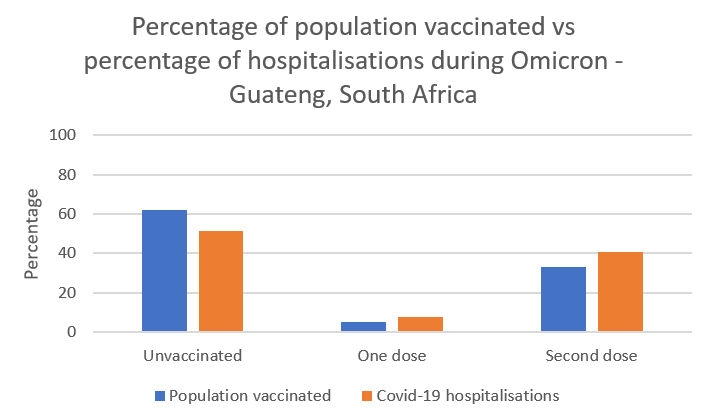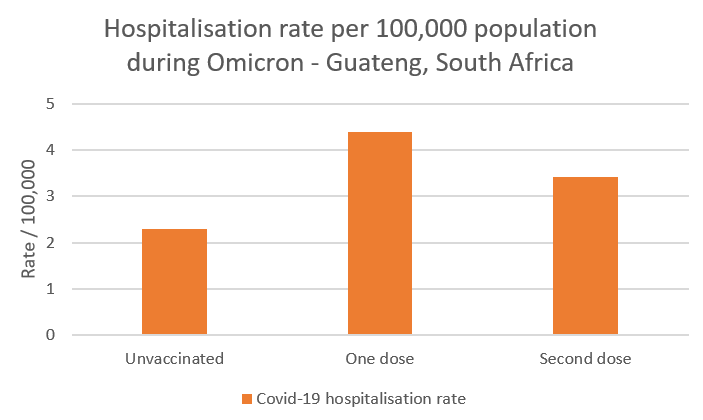Negative Vaccine Efficacy against Omicron in South Africa
And further insight in to the severity of Omicron
Yet another study showing waning vaccines and the possibility of Original Antigenic Sin (OAS) starting to occur. The study looked at the effectiveness of the Pfizer vaccine against the Omicron variant in South Africa between 15 November and 7 December. It compared hospitalisations and positive tests with the Delta wave between 1 September and 31 October in the Guateng Province.
The authors conclude that during the beginning of the Omicron period, they found a vaccine effectiveness of 70% against hospitalisation. Thus, they saw a maintenance of effectiveness of the Pfizer vaccine (albeit at reduced levels) against hospital admission for COVID-19. They finish by saying a booster dose may mitigate this reduction in effectiveness. However, when looking at the data itself we can draw different conclusions.
Firstly, looking at vaccine efficacy, 73.9% of patients hospitalised during the Delta wave were unvaccinated. The current level of vaccination in the Guateng Province is around 33% so during the Delta wave it would have been much lower. The current level in the whole of South Africa is 26%, so Guateng clearly vaccinates at a higher rate (a difference between national level and Guateng is 27%). So using this 27% difference we can look at the national level of vaccination during Delta and approximate the Guateng level at the time. National levels of vaccination were on average 15% during the Delta period used in this study so adding on 27% means an approximate 19% vaccination rate in Guateng.
Looking at the chart above, it is clear that even during the Delta wave, vaccinations were not doing anything. Just to be clear, to make things more simple, I lumped together all vaccines (8.3% Pfizer, 8.6% other) and <14 days after second dose (1.4%) in the same ‘Second dose’ category and will do so throughout the rest of this article.
Now, moving on to the Omicron wave, only 51.3% of hospitalisations were unvaccinated. So with current vaccination levels at 33% we can see increasing negative vaccine efficacy.
Taking an estimated population size of 15.5 million for Guateng we can calculate hospitalisation rates per 100,000 for Omicron.
Looking at the rates of hospitalisations per 100,000 shows more clearly the difference between the unvaccinated and vaccinated during Omicron.
Secondly, does the data give us a clue as to how mild Omicron is?
The delta period was much longer (61 days) than the Omicron one in the study (23 days) but by looking at number of hospitalisations per day it seems Omicron is actually worse. There were 15.16 hospitalisations per day with Delta but 18.65 per day during Omicron.
This is not because Omicron is more severe, it’s because it infects at a much quicker rate. There were 140 positive tests per day with Delta but an almost 6 fold increase at 829 tests per day with Omicron. Furthermore the number of positive tests compared with tests administered was much higher with 6.4% of the tests during Delta versus 24.4% during Omicron. Luckily the percentage of hospitalisations from positive tests dropped significantly with 10.8% during Delta versus 2.2% in Omicron.
So, Omicron transmits much more quickly resulting in a higher amount of positive tests per day but fortunately with a lower hospitalisation rate. However, due to the much larger numbers and speed of Omicron, the number of hospitalisations per day is actually 23% higher.
Breaking this down by vaccination status and adjusting for population reveals where the increase has come from.
Whilst all the groups, have dropped in hospitalisation rates, the second dose group has only dropped by 41% compared with the one dose group (52%) and the unvaccinated (61%). The speed of transmission and infection, coupled with a smaller drop in hospitalisation rates in the vaccinated has resulted in general hospitalisation rates for COVID-19 actually being higher.
Does all of this further the evidence of OAS in the vaccinated group, resulting in higher rates of hospitalisations when compared with the unvaccinated? Have the unvaccinated group gained a broader immunity so coping with Omicron much better?
I am guessing this is why the push for boosters has been so great in the Western world. South Africa has a much larger section of the population that is unvaccinated and as we have seen above, hospitalisation rates are dropping much more quickly in the unvaccinated. Without the boosters and with such a large proportion of the population being double vaccinated, we would probably be seeing just as high numbers in hospital as this time last year, if not more.
However, when the waning of the boosters begins (it has already started in the most vulnerable who had theirs first) or if Omicron begins to ramp up more, will we see high hospitalisation rates again? - probably. Even if they have managed to time the boosters perfectly, what happens next Winter or with the next new variant? Constant boosters to top up antibody levels because the broader immune response is just not as responsive? This is not a good long term solution or is it the case that we are now trapped in some negative booster spiral where this is the only route to follow?









This is a great article, although possibly age confounding will reveal that the bad effects of the vaccine are not quite as large.
But still we are living through the exciting and predicted time of vaccine failure and I thank you for exposing a part of this story.
You (and everyone else saying similar things) have not convinced me on a couple of points which I think the analysis needs to address.
Firstly, the very problematic concept of "unvaccinated". This aggregates the recovered and the immune naive (not having been infected with the virus at all). The proportion between these two categories has changed between the two waves and you need to take account of this.
Secondly, the comparison you make ignores the fact that the vaccinated are more likely not to have had delta. The fact that they are now getting omicron at increased rates may simply reflect this fact. So the vaccine has allowed some of them to "swap" omicron for delta, which would be a good thing. This is not evidence of OAS and, honestly, I don't want to be impolite, but I think it is a sloppy way to reason.
Lastly, I have yet to see analysis from anyone which recognizes that the hospitalized with omicron in SA are in most cases incidental, that the reduced severity of omicron makes further underdetection highly likely and that relative to the likely population incidence, a higher proportion of detected cases is likely to have been detected in a hospital setting where people are tested systematically. In other words, there is a base rate fallacy.
These are some quick thoughts off the top of my head and I would be interested in your reaction. I am not expecting epidemic new variants personally. I do agree with everyone who has made this point that on a precautionary basis the vaccine policy has been all wrong and we should have relied much more on natural immunity in the healthy and not vulnerable part of the population. I don't think anyone has yet shown OAS or ADE. In fact, Geert vanden Bossche, who has very much warned of this, seemed to be quite upbeat recently that omicron was in fact solliciting a broad spectrum immune response in the vaccinated as well. See https://www.voiceforscienceandsolidarity.org/scientific-blog/like-a-virgin-untouched-forever